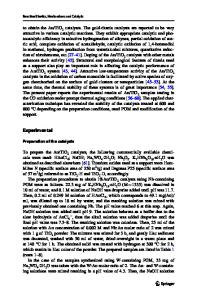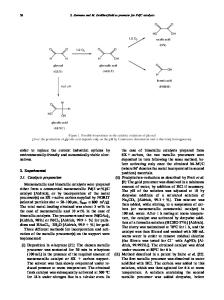Nanocrystalline gold and gold-palladium as effective catalysts for selective oxidation
- PDF / 503,274 Bytes
- 11 Pages / 612 x 792 pts (letter) Page_size
- 93 Downloads / 304 Views
0900-O01-07.1
Nanocrystalline gold and gold-palladium as effective catalysts for selective oxidation Jennifer Edwards, Philip Landon, Albert F. Carley, Andrew Herzing,1 Masashi Watanabe,1 Christopher J. Kiely 1 and Graham J. Hutchings Department of Chemistry, Cardiff University, Main Building, Park Place, Cardiff, CF10 3AT, UK 1 Center for Advanced Materials and Nanotechnology, Lehigh University, 5 East Packer Avenue, Bethlehem, PA 18015-3195, USA. ABSTRACT The recent interest in oxidation catalysis provides the focus for this paper. Until recently gold has been overlooked as a key component of both homogeneous and heterogeneous catalysts. However, the observation in the 1980’s that nanocrystalline gold supported on oxides was an effective catalyst for low temperature carbon monoxide oxidation has now captured the imagination of many researchers. At present low temperature carbon monoxide oxidation remains an intensely studied field, but in recent years increased emphasis has been placed on using gold catalysts for selective oxidation. For example the oxidation of alkanes, alkenes and alcohols have all been shown to be effective with gold based catalysts. In addition gold palladium catalysts have been shown to be very effective for the direct formation of hydrogen peroxide and this will be described in this paper. INTRODUCTION The discovery in the 1980’s that supported nanoparticles of gold could act as catalysts for reactions at low temperatures has to be one of the most fascinating recent observations in chemistry, since before this observation most researchers considered that gold was an unreactive metal. As gold is such a stable element in the presence of air it is really surprising that it can be a highly effective oxidation catalyst. It is all the more surprising since bulk gold does not chemisorb oxygen, which is a prerequisite for oxidation catalysis at a surface. Consequently, a large number of experimental and theoretical studies are being undertaken to try to elucidate the nature of this interesting catalytic activity. This recent research has been reviewed by Haruta [15], Bond and Thompson [6-7], Thompson [8], Freund and co-workers [9], Cortie [10], Hashmi [11-12], Hutchings [13-15] and Hutchings and Scurrell [16]. The position of gold in the periodic table is also of interest, since it is surrounded by elements that are used in a broad range of catalytic processes including oxidation. Hence, there should not have been too much surprise when it was found that gold was active, indeed some argued that it was the impurities present in gold that led to the observed activity. However, since gold was considered to be inert few experimental studies explored this area until the seminal studies of Haruta [17] who discovered the high activity of gold for CO oxidation at subambient temperature. This new discovery opens up the possibility of gold acting as an effective oxidation catalyst and recent studies are confirming this to be the case. Bond and co-workers [18] in early studies demonstrated that very small gol
Data Loading...











